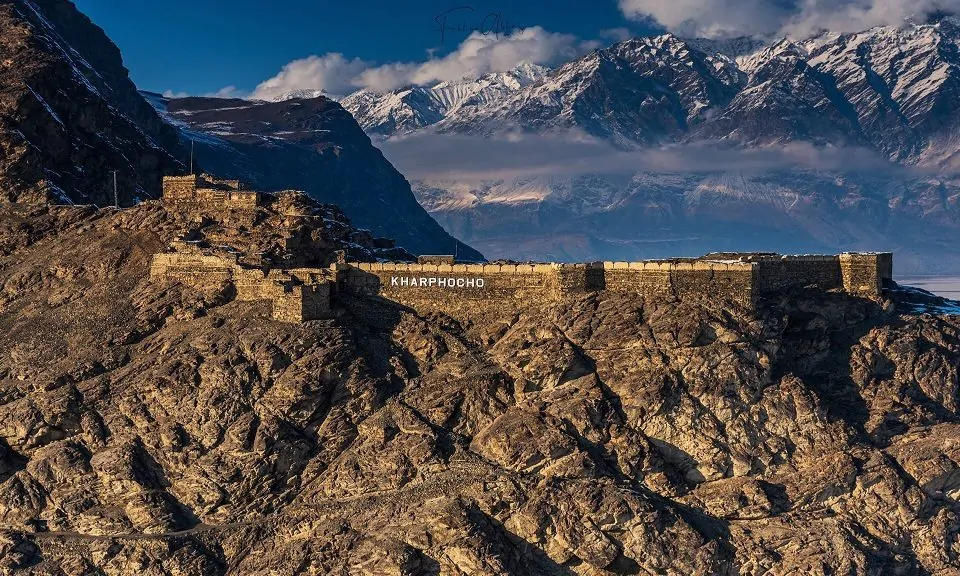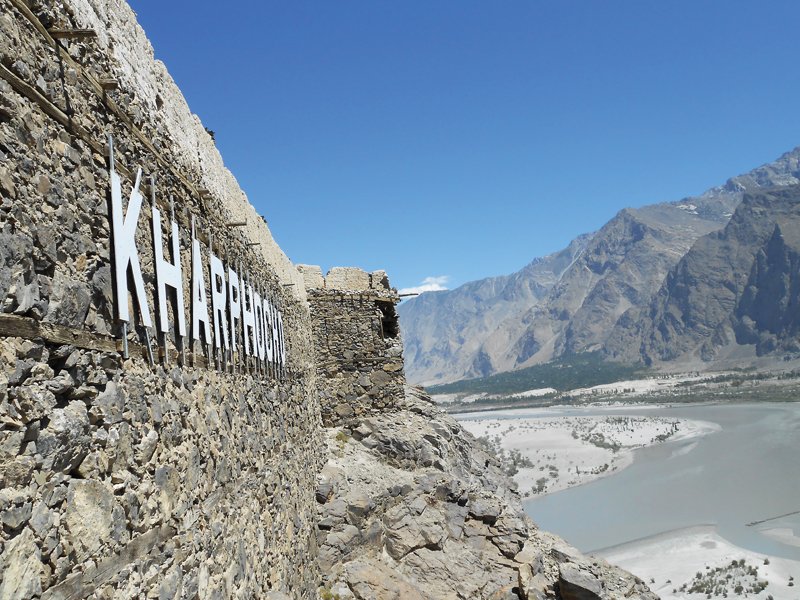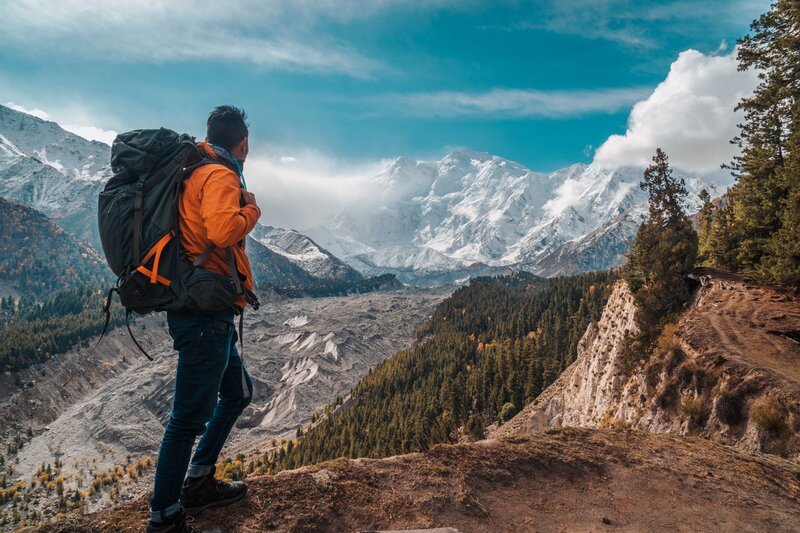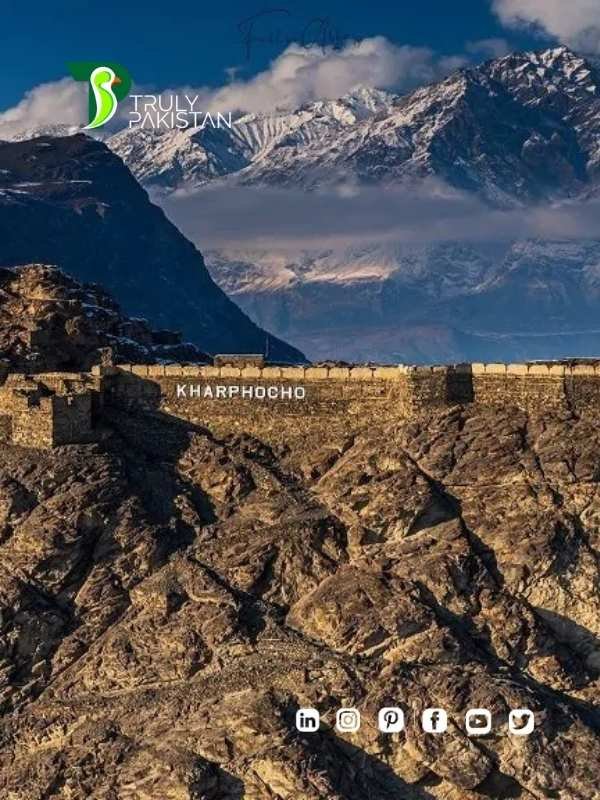Kharpocho Fort – A Historic Gem of Skardu


Kharpocho Fort, known as the “King of Forts,” rises above Skardu in Gilgit-Baltistan with an aura of power and resilience. Perched on a mountain overlooking the Indus River, it has witnessed centuries of rulers, battles, and cultural transformations. Today, it stands not just as a ruin but as a living reminder of Baltistan’s strength and history.
If you are curious about where history meets breathtaking landscapes, Kharpocho Fort offers both. This guide brings together everything you need — its story, its architecture, and practical tips for visiting — in one place.
History of Kharpocho Fort
Construction by Ali Sher Khan Anchan (1490–1505)
Kharpocho Fort was commissioned by Ali Sher Khan Anchan, the ruler of the Maqpoon dynasty, around the turn of the 16th century. Built between 1490 and 1505, it was designed as a defensive stronghold to protect Skardu from outside invasions. The fort’s location was no accident — its steep cliffs and commanding views over the valley gave it a natural advantage against enemies.
- Strategic site: Positioned above the Indus River with panoramic views.
- Purpose: A military fortress and seat of power for the Maqpoon dynasty.
- Legacy: Foundation for Skardu’s prominence as a regional capital.
The Maqpoon dynasty and Dogra invasion of 1840
For centuries, the fort remained the residence of the Maqpoon rulers, symbolizing authority in Baltistan. However, in 1840, the Dogra forces led by General Zorawar Singh invaded and captured Kharpocho Fort. Despite the fort’s strong defenses, the invaders succeeded and parts of the structure were heavily damaged. This marked the end of its role as the capital stronghold and shifted Baltistan’s political landscape.
Architecture and Design of Kharpocho Fort
Defensive walls and strategic layout


The architecture of Kharpocho Fort is a blend of functionality and cultural expression. Thick stone walls, narrow entry points, and elevated watchtowers reveal its purpose as a fortress built for defense. Every angle of the fort was positioned to deter invaders while keeping control over the valley below.
Balti architectural elements and local materials
The fort reflects Balti architectural traditions with its use of locally available stone, timber, and mud mortar. The builders adapted their techniques to the harsh mountain environment, making the structure both strong and sustainable. Wooden beams reinforced the ceilings, while stone masonry blended seamlessly into the natural rock of the hilltop.Materials used: Stone masonry, timber beams, mud mortar Design style: Balti defensive architecture with natural adaptations Strategic features: Watchtowers, steep approaches, narrow pathways
Restoration efforts and current condition
Over the years, limited restoration has been attempted to stabilize the remaining structures. Some portions of the fort, including the walls and small chambers, are still intact, while others are reduced to ruins. Despite its incomplete preservation, Kharpocho Fort retains its commanding presence, attracting historians, photographers, and travelers from around the world.
Visiting Kharpocho Fort
How to reach Skardu and access the fort
Kharpocho Fort is located in Skardu, the main town of Baltistan in Gilgit-Baltistan. Visitors can reach Skardu by air from Islamabad or by road via the Karakoram Highway. The fort itself requires a short hike uphill from the town center, offering sweeping views of the valley along the way.
Best time to visit and weather considerations
The ideal time to visit is between May and October when the weather is clear and the hiking paths are safe. Winter months can make access difficult due to snow and extreme cold.
Hiking routes, safety tips, and photography spots


The trail to Kharpocho Fort is moderate in difficulty and takes about 30–40 minutes on foot. Visitors should wear sturdy shoes, carry water, and avoid hiking after dark. The fort provides excellent photography opportunities, especially at sunrise or sunset, with views of the Indus River and nearby peaks.
Guided tours and visitor facilities
While there are no formal ticketed entry points, local guides in Skardu often offer tours that include stories of the Maqpoon dynasty and the Dogra invasion. Facilities are limited at the fort, so visitors are advised to bring their own refreshments and plan for a rustic experience.
Cultural Significance and Legacy
Role in Baltistan’s identity and heritage
Kharpocho Fort is more than a historical monument. For the people of Baltistan, it represents pride, endurance, and a connection to their rulers of the past. Its strategic importance and survival through centuries make it a cultural anchor for the region.
Legends and myths around Kharpocho Fort
Local folklore is filled with tales about the fort. Some stories describe secret passages leading to the Indus River, while others speak of mythical treasures hidden within its walls. These legends add a layer of mystique, blending history with imagination.
Influence on local art, architecture, and memory
The fort’s architecture and stories have inspired Balti art and poetry for generations. It remains a frequent subject in cultural festivals, folk songs, and even modern documentaries, keeping its memory alive across different forms of expression.
FAQ on Kharpocho Fort
Who built Kharpocho Fort?
The fort was built by Ali Sher Khan Anchan, ruler of the Maqpoon dynasty, between 1490 and 1505.
Where exactly is Kharpocho Fort located?
Kharpocho Fort is situated on a rocky hilltop overlooking the Indus River in Skardu, Gilgit-Baltistan, Pakistan.
Is Kharpocho Fort open to tourists?
Yes, visitors can hike up to the fort ruins. Entry is free, though facilities are limited and the climb requires basic fitness.
What is the best time to visit Kharpocho Fort?
From May to October, when the weather is clear and hiking trails are accessible, is the best period to visit.
What makes Kharpocho Fort culturally important?
It symbolizes Baltistan’s resilience and heritage, blending historical significance with cultural myths and traditions.
Conclusion
Kharpocho Fort is not just a relic of the past, it is a monument that tells the story of Baltistan’s resilience and cultural pride. From its construction by Ali Sher Khan Anchan to its battles with invading forces and its enduring legacy, the fort continues to inspire visitors and locals alike. Standing atop Skardu with panoramic views of the Indus Valley, it offers history, beauty, and a glimpse into the heart of Gilgit-Baltistan.
Related Post: Top 10 Forts of Pakistan: Exploring the Rich History and Architecture


Author: ZunNurain Khalid — Travel & Tourism Specialist, Founder of ExploreX Pvt. Ltd., and advocate for sustainable tourism in Pakistan. With over a decade of experience in digital marketing and destination branding, ZunNurain has worked extensively on promoting Pakistan’s natural and cultural heritage.

